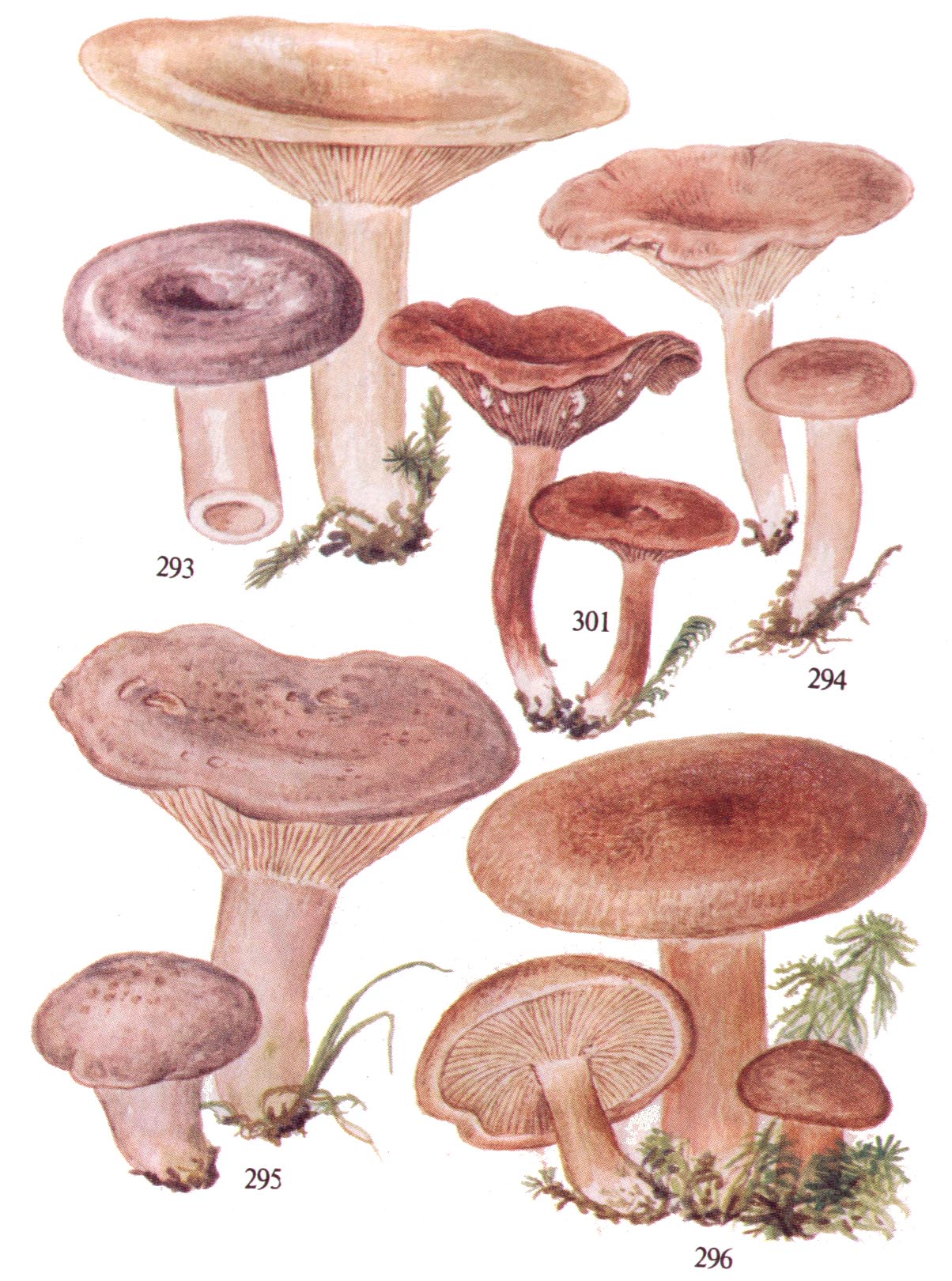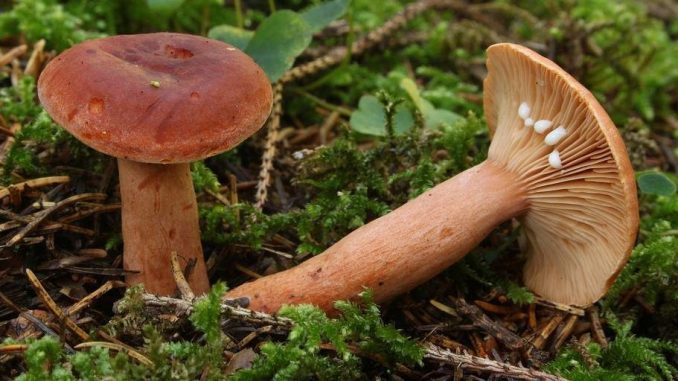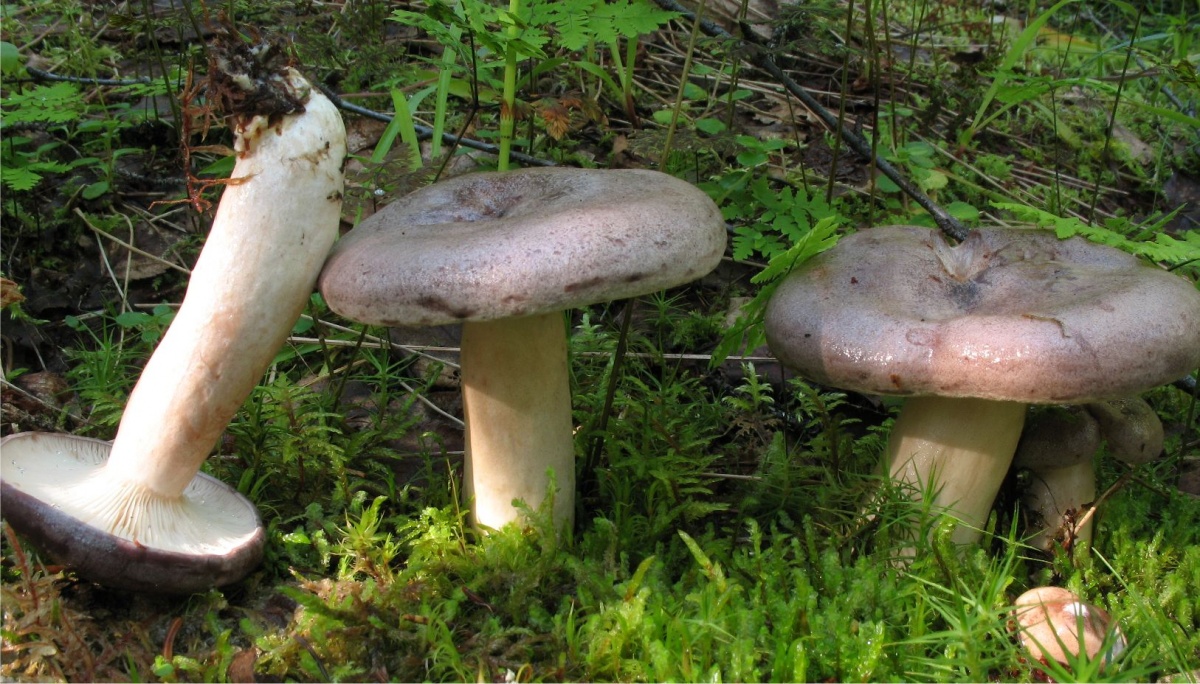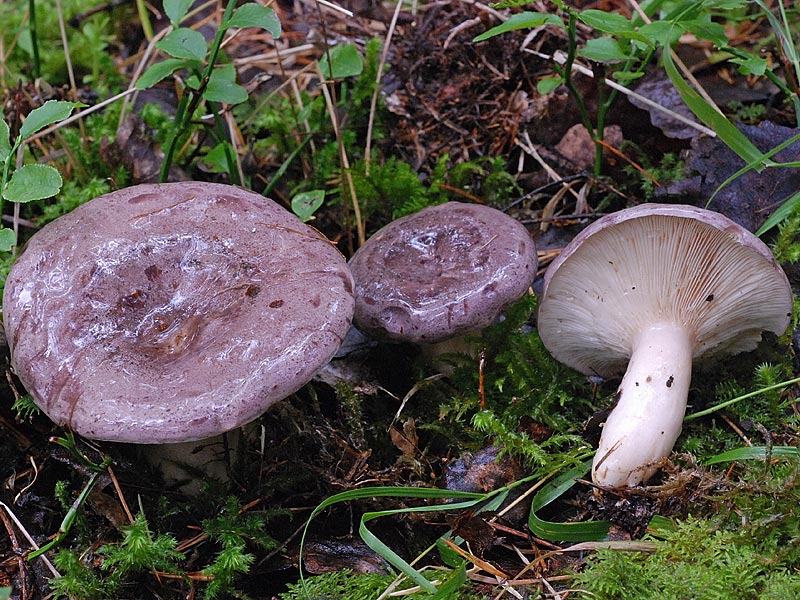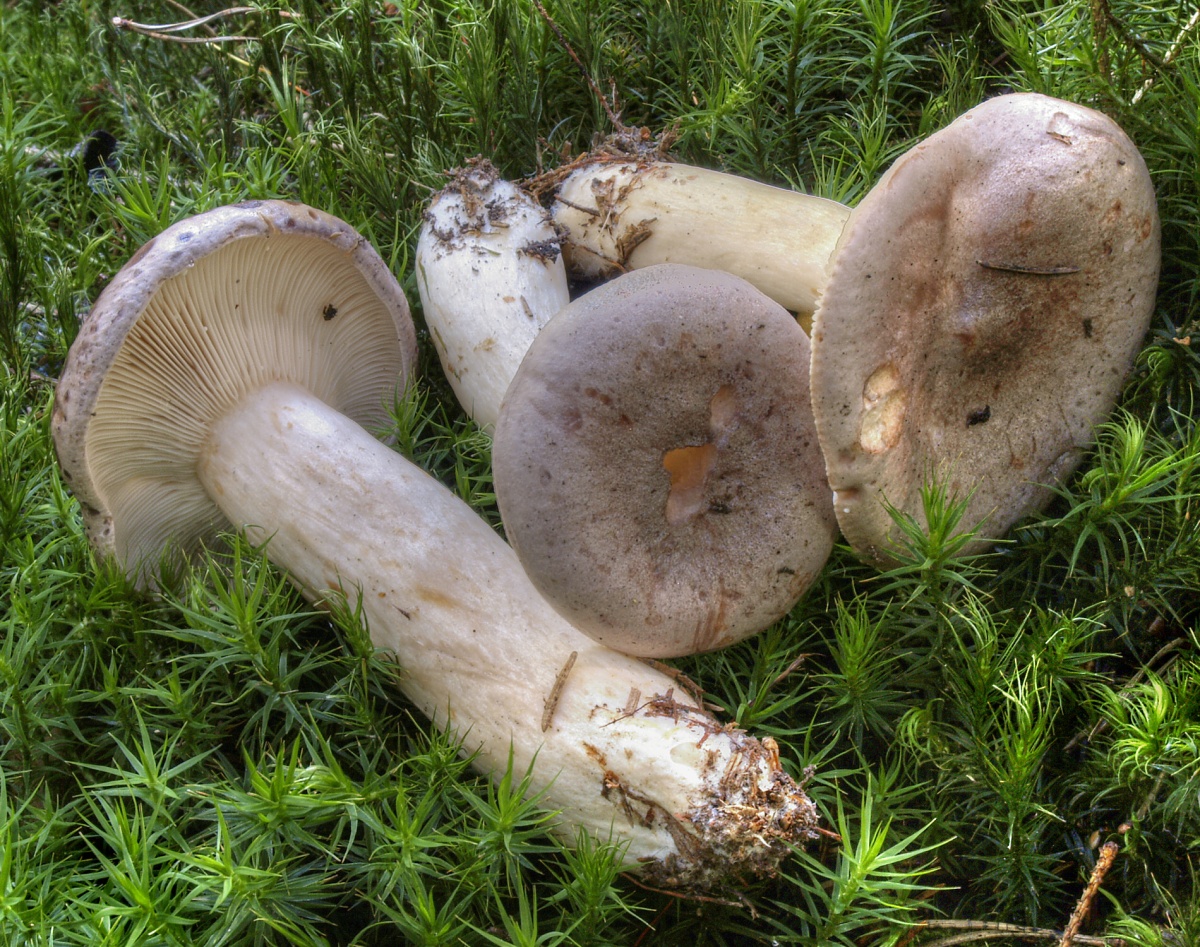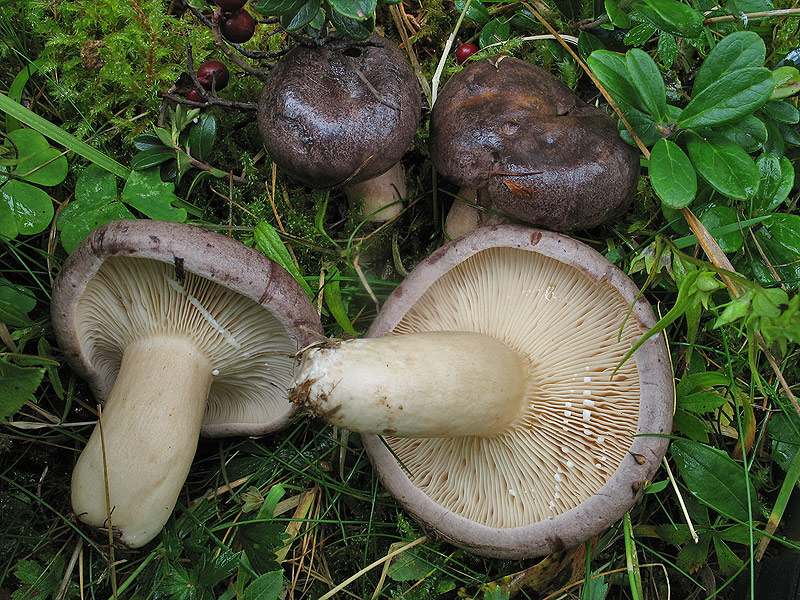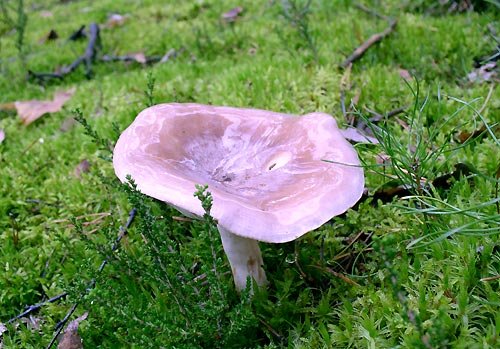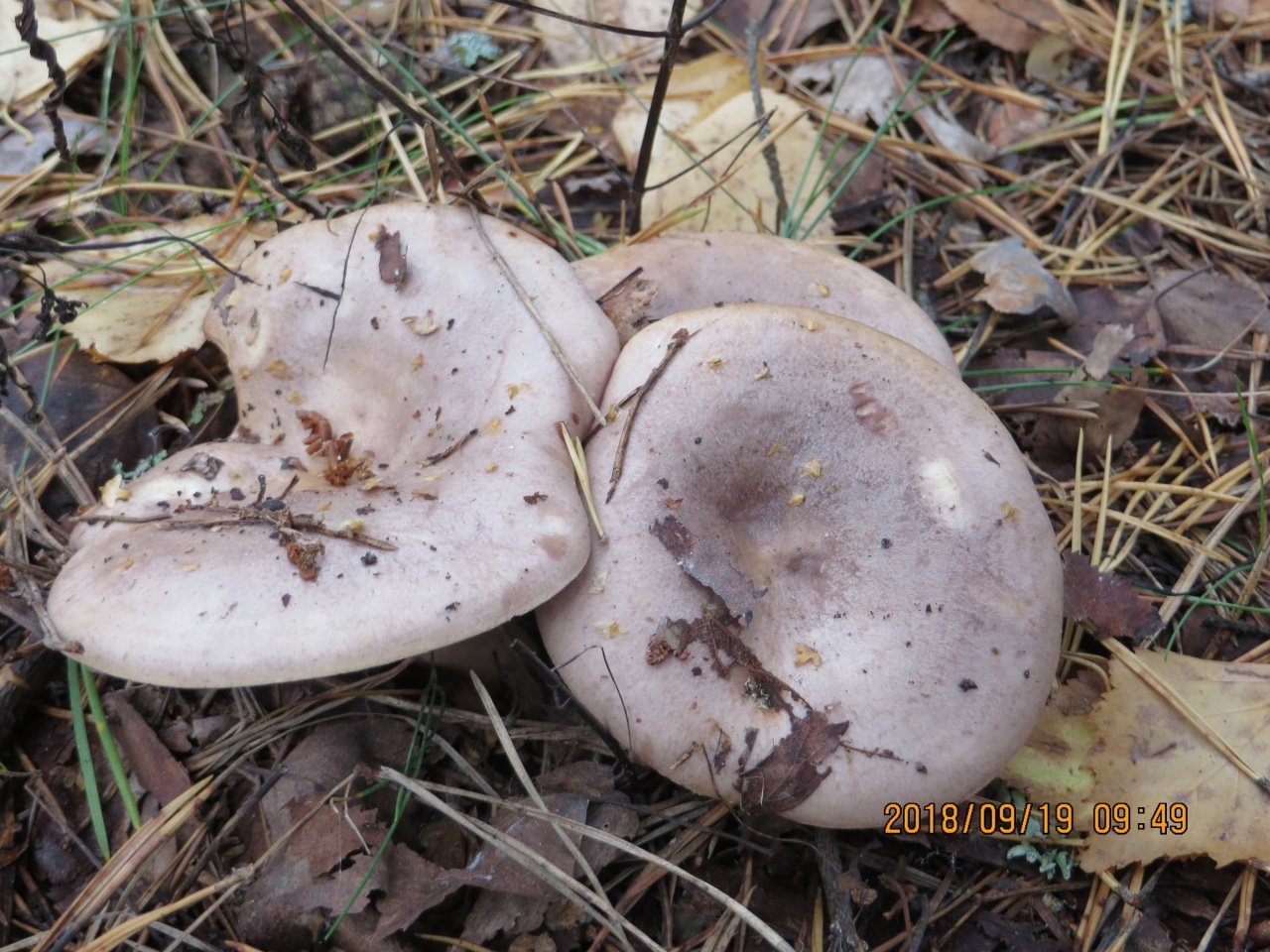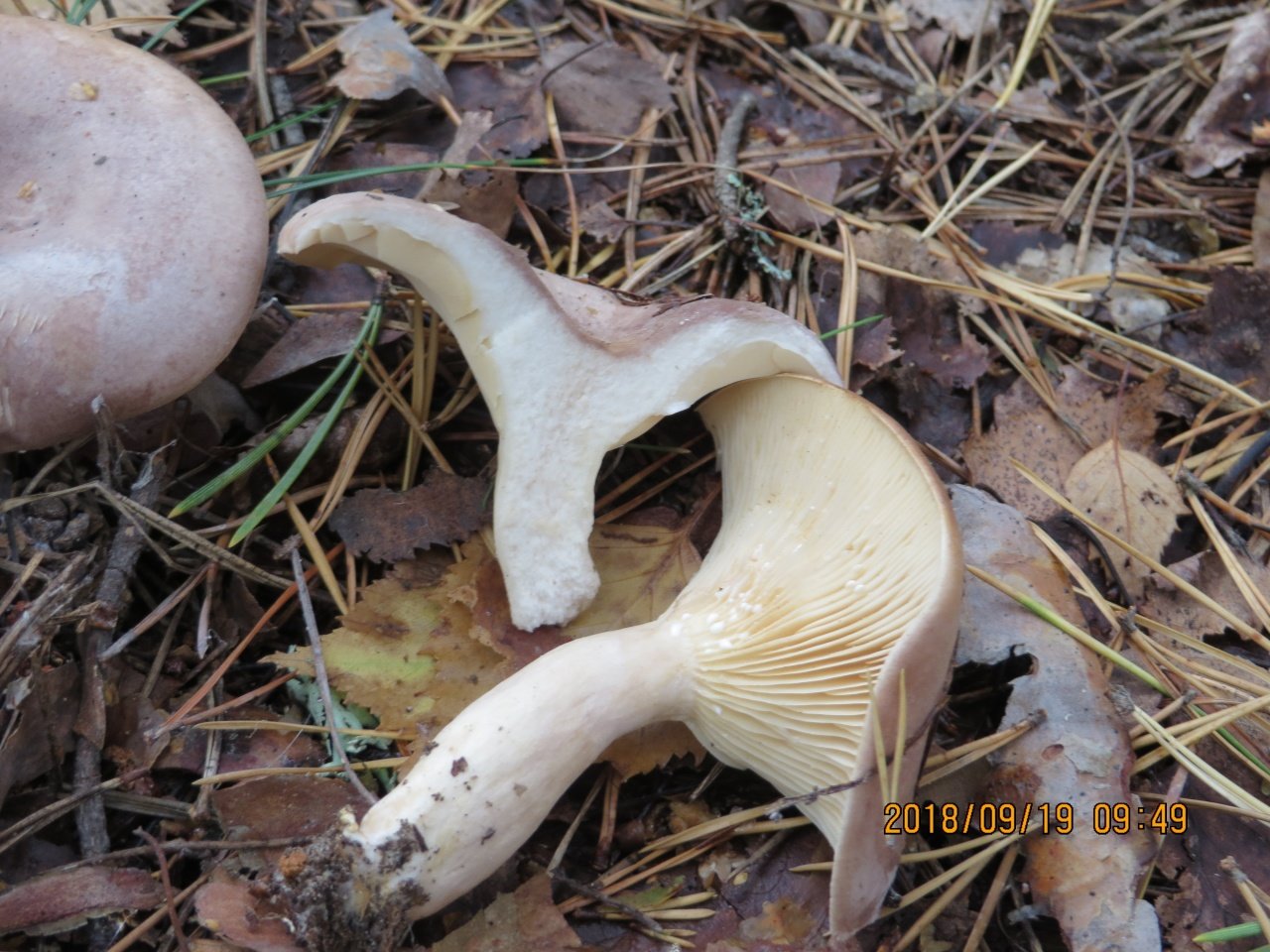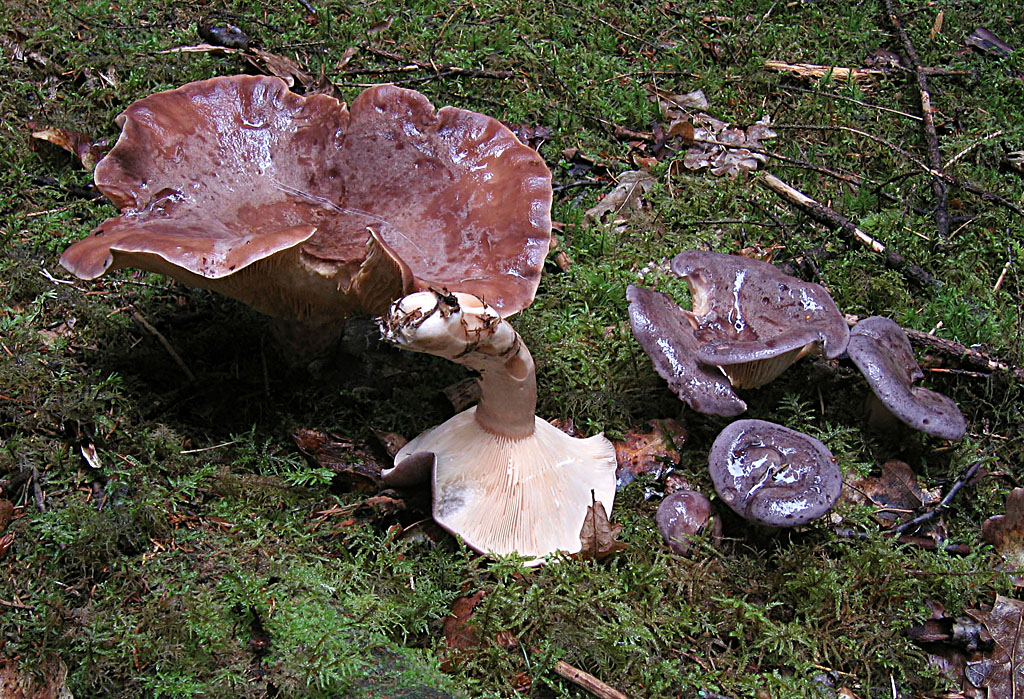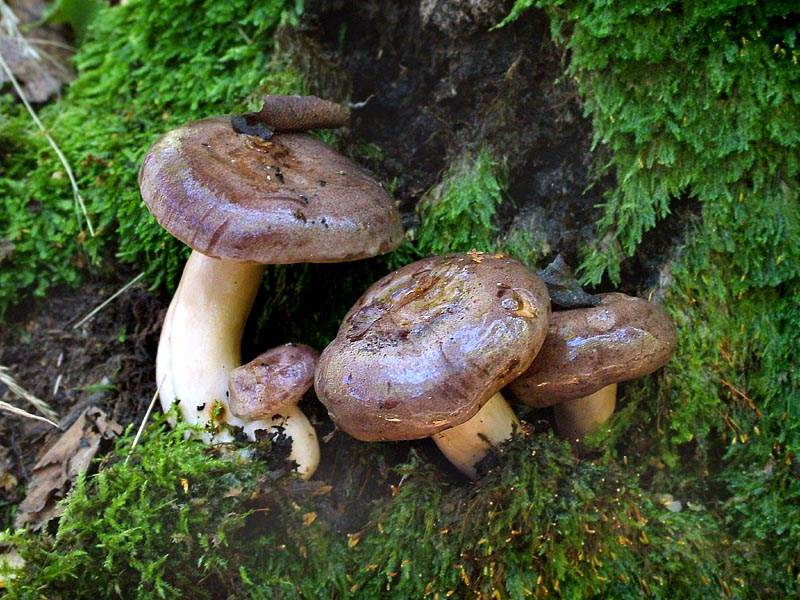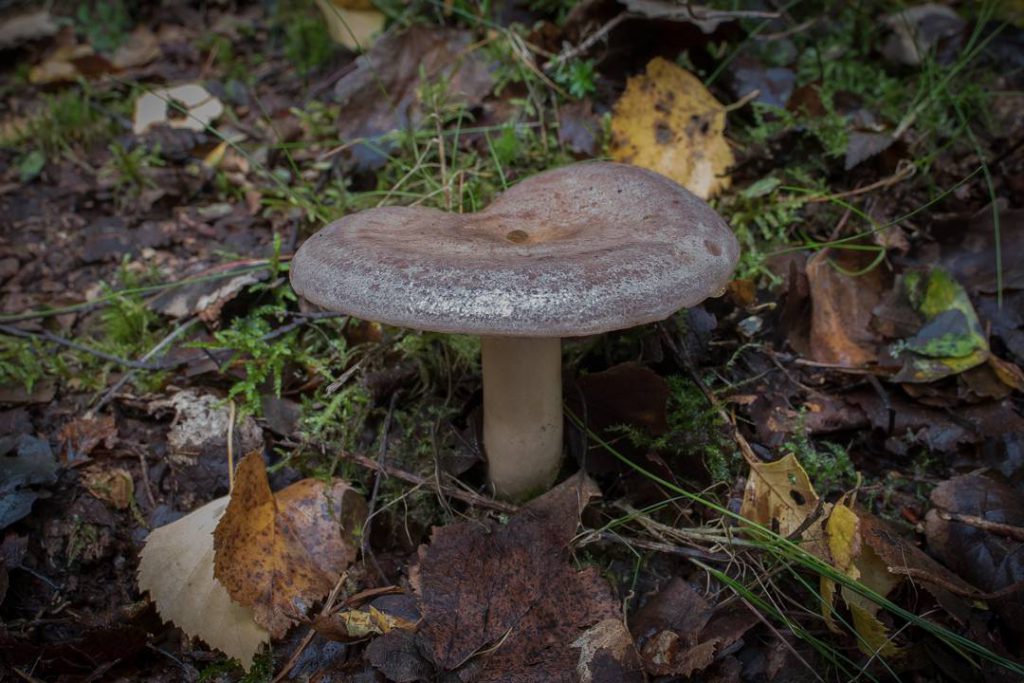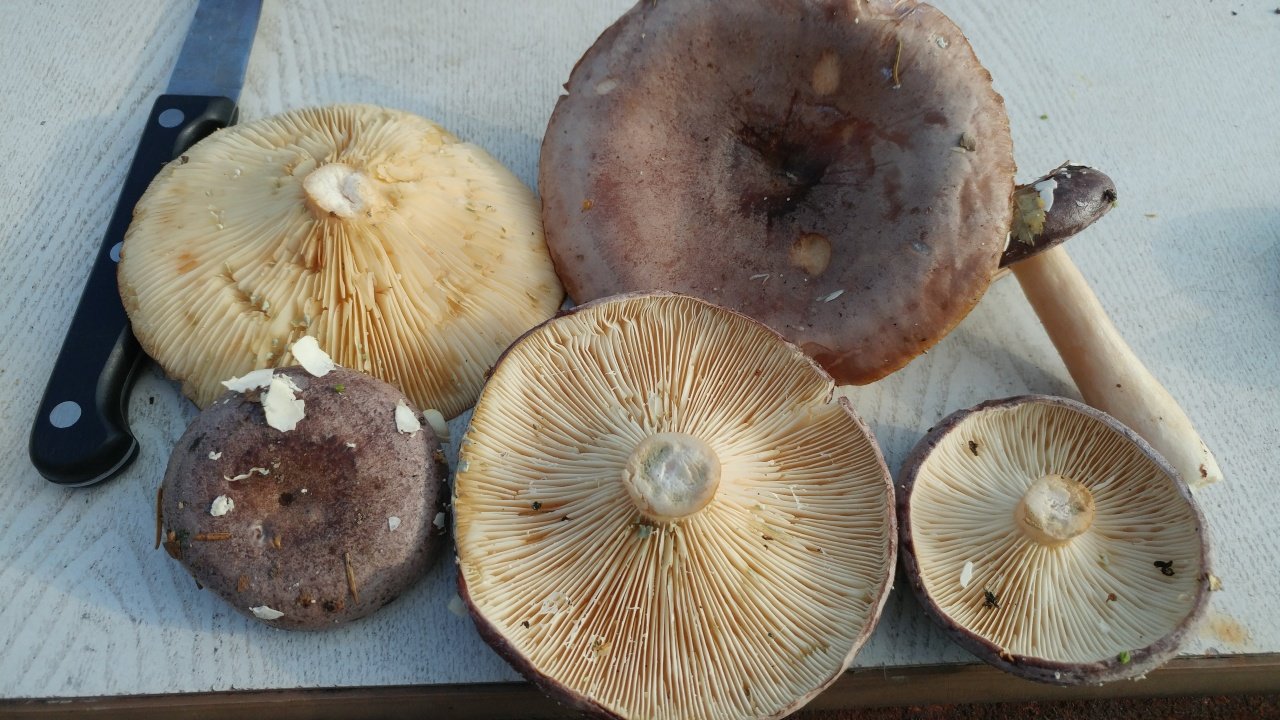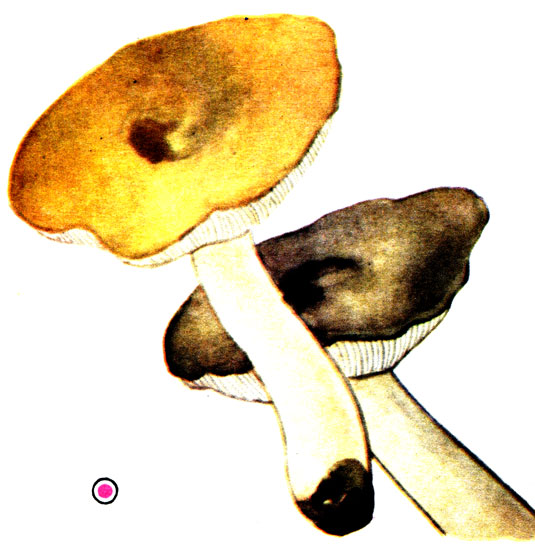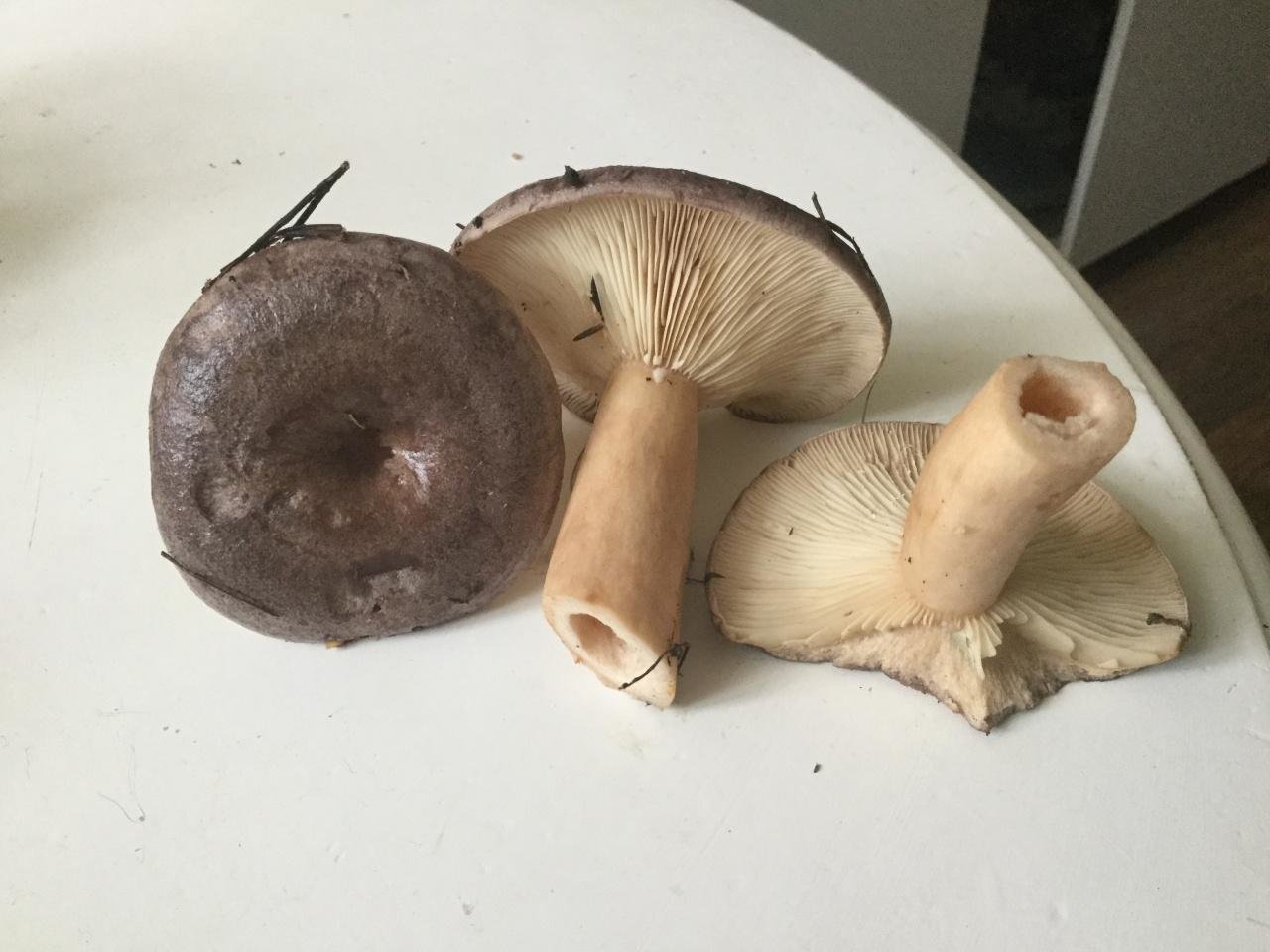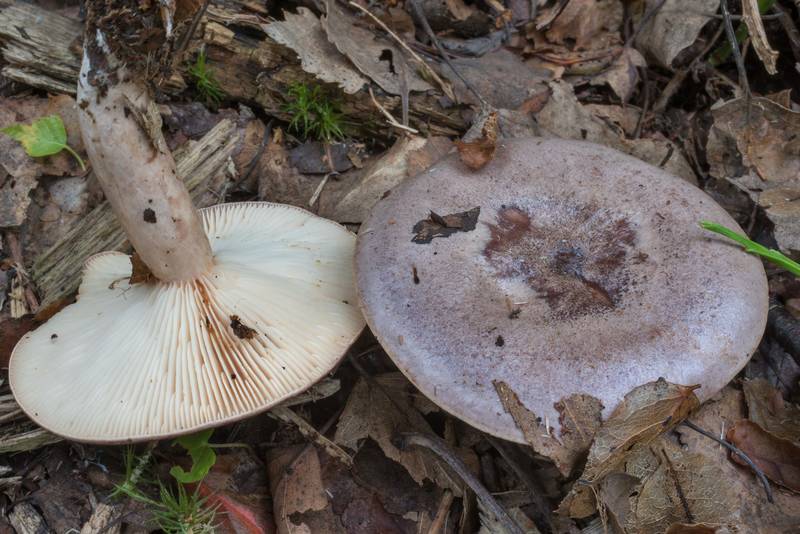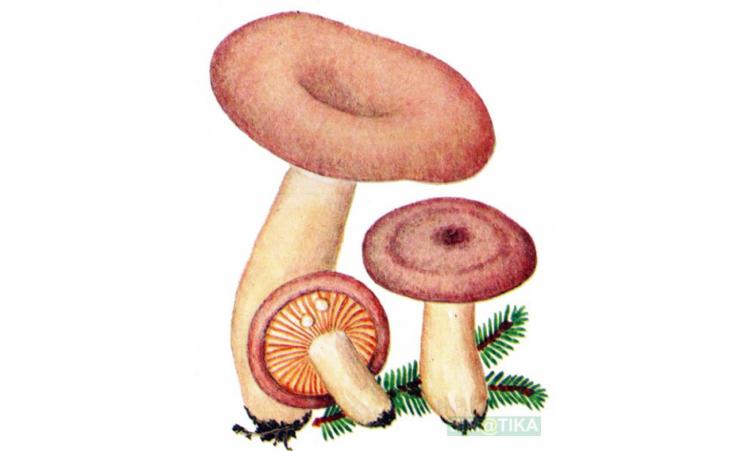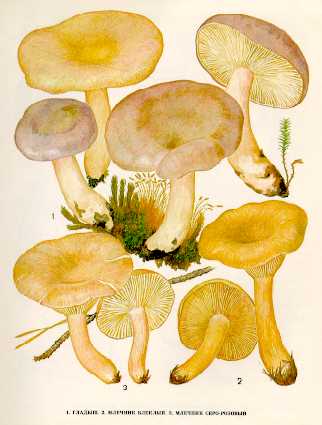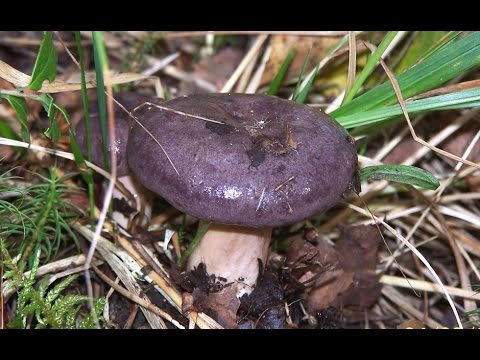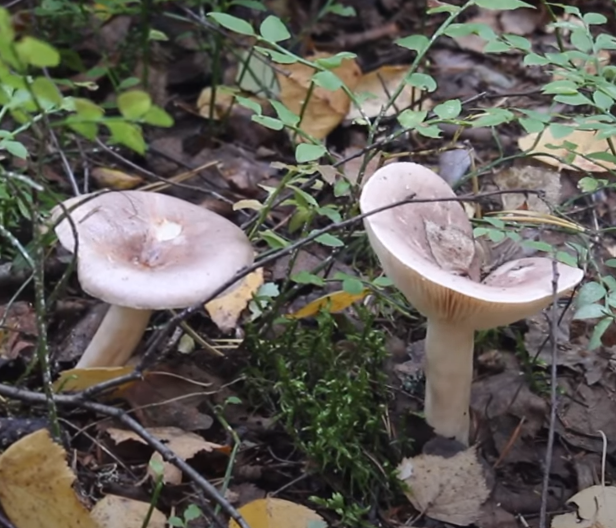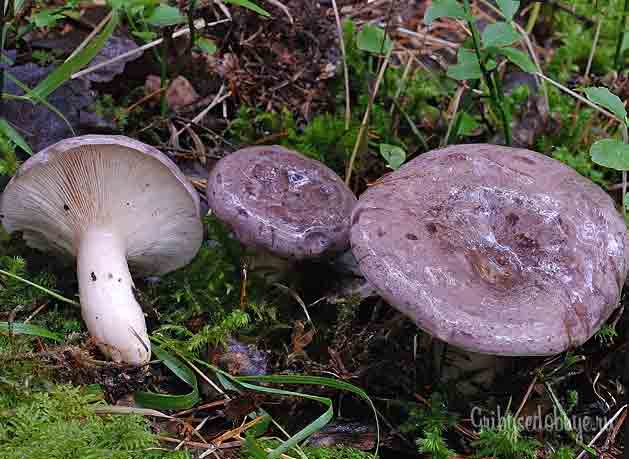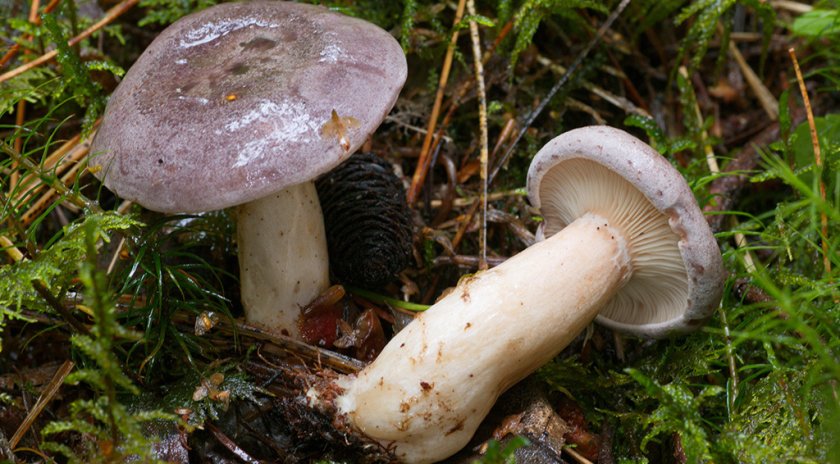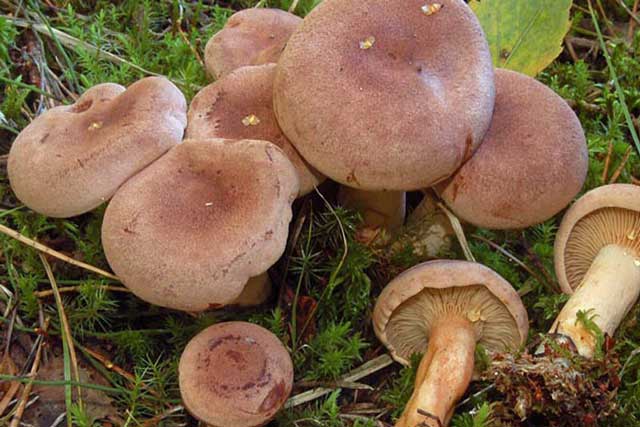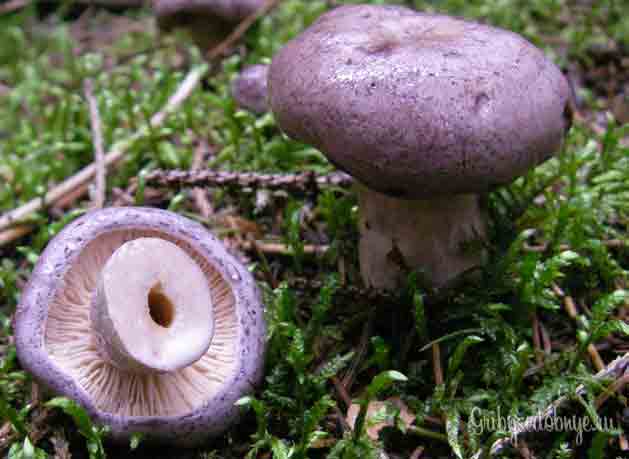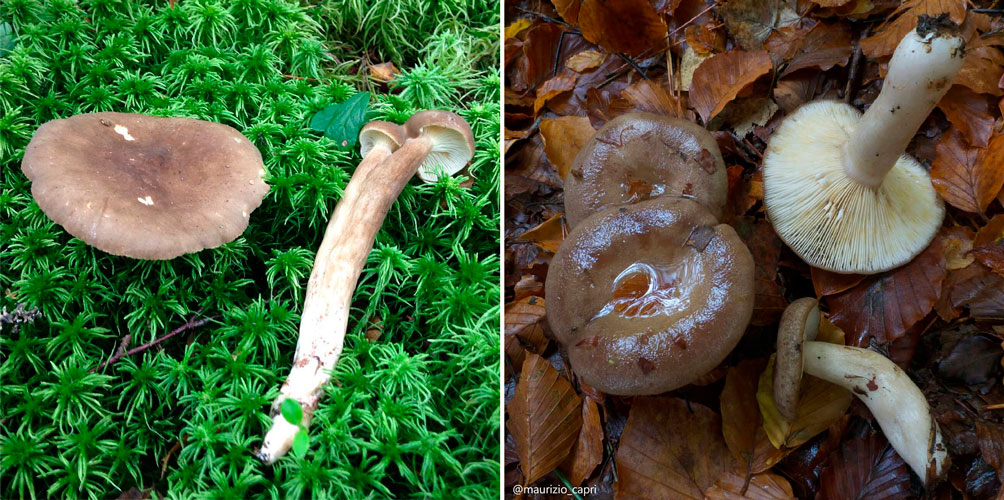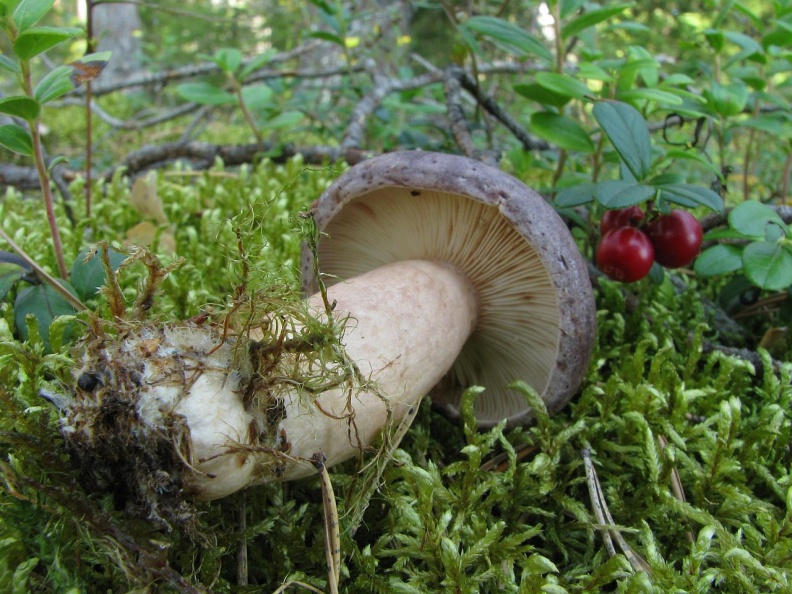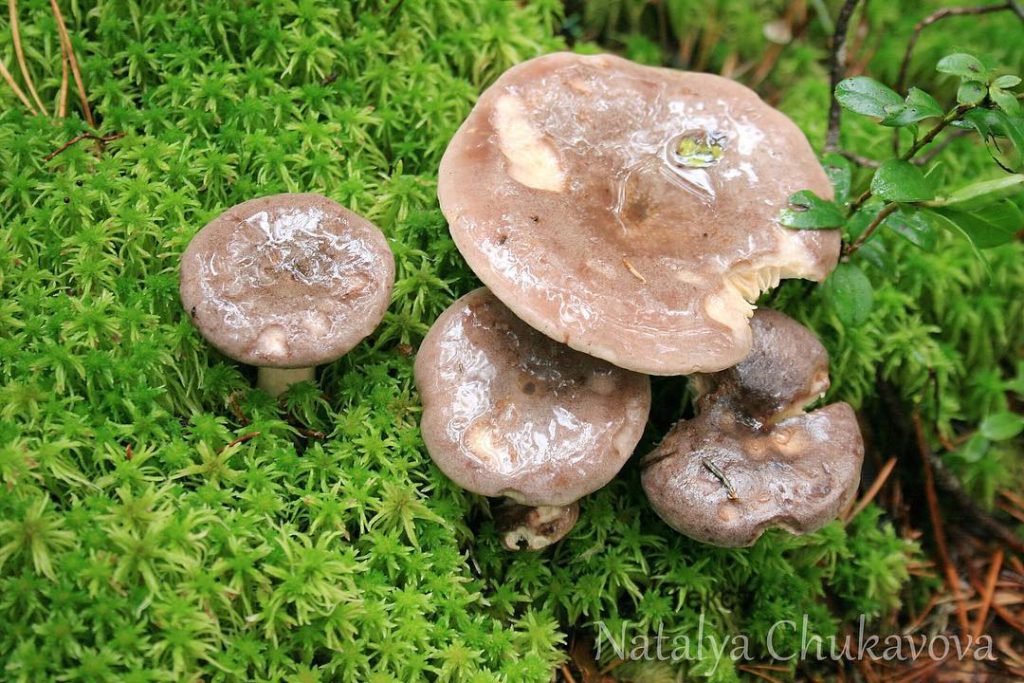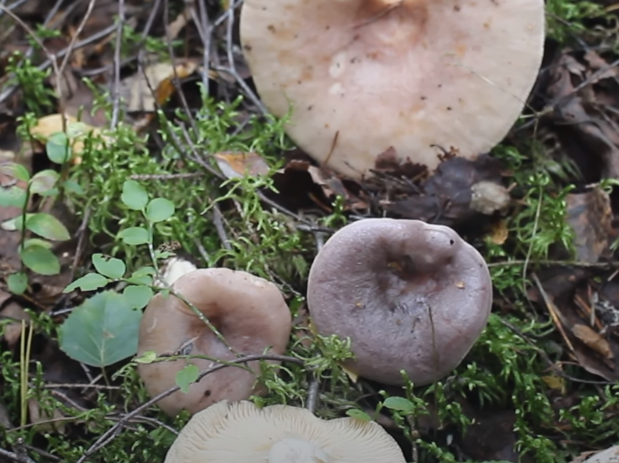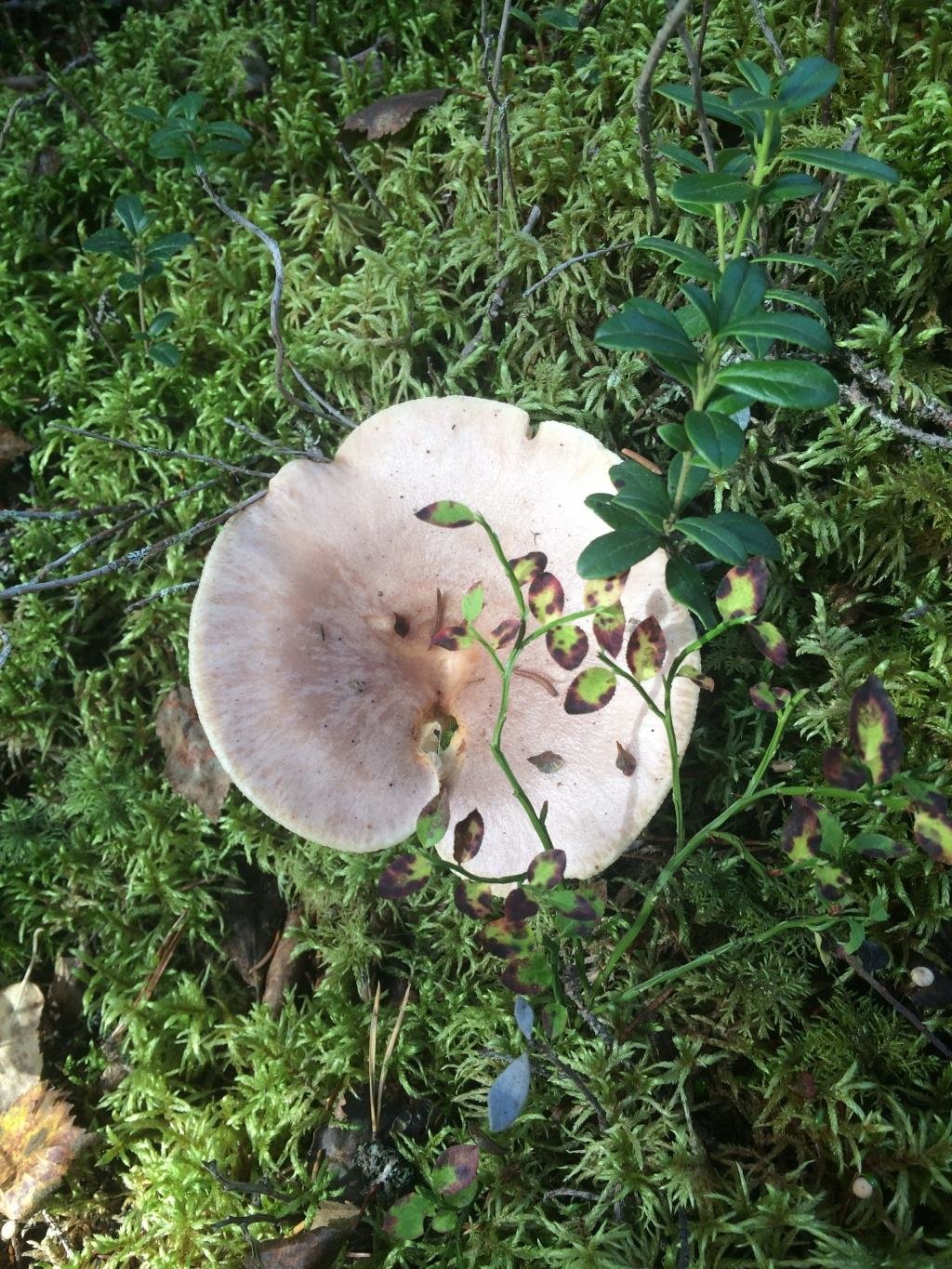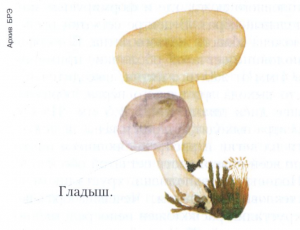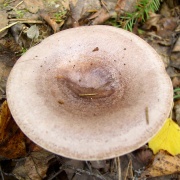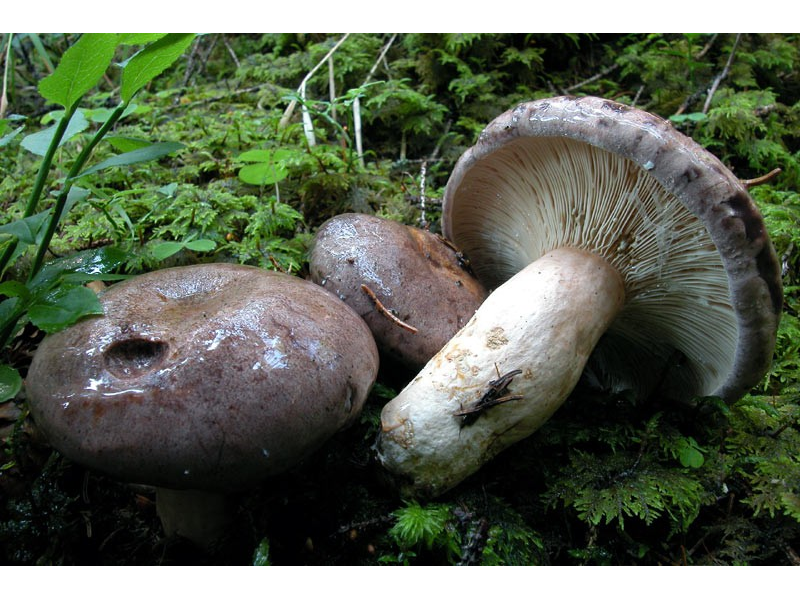General description of the milkmen
Millers, or lamellar mushrooms from the russula family, are called Lactarius in Latin and are translated as "dairy" or "milk-giving". They can vary greatly in appearance. Most often they have a lamellar cap and a centered leg without a cover; in some varieties, the leg is thick and short. The cap of the fungal genus is usually flat, slightly concave or funnel-shaped, with plates on the lower surface descending to the stem.
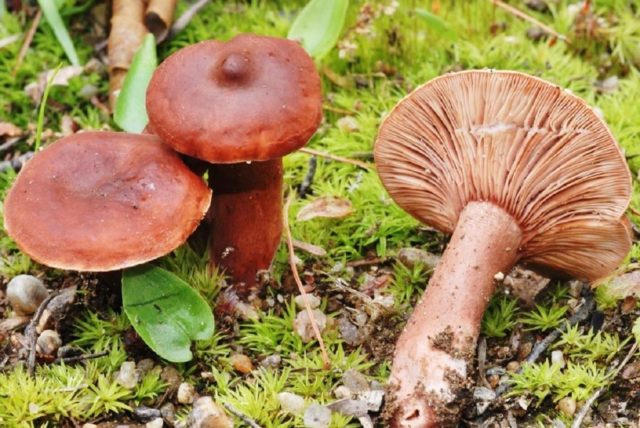
The genus Lactarius has several hundred varieties, both edible and inedible.
In color, the fruit bodies differ very widely and can be white and olive-black, grayish and bluish, yellow and orange, brown and brown. The color depends on the specific variety. Likewise, the skin on the surface of the cap can be dry and velvety or sticky and gooey.
Important! Of about 400 species of fruiting bodies of this genus, only about 50 species can be found on the territory of Russia. Many of them are edible, although they require pre-processing.
Edible varieties
Swamp bush
The cap is small, up to 5 cm, prostrate or funnel-shaped with tubercles in the middle. The skin is reddish, brick, ocher, often fades with age.
The leg is dense and abundantly pubescent below. Color to match the hat or slightly lighter. Hollow, sometimes with a channel in the middle.
The plates are frequent and reddish, passing to the peduncle. The pulp is creamy, unpleasant in taste. Milky sap is whitish, turns gray in the air, may turn yellowish. In old mushrooms, it is pungent and pungent, but in young mushrooms it is sweetish.
Glaucous lactus
The cap is flat in youth, after funnel-shaped. The skin is dry and smooth, it can be velvety. In old fruiting bodies, the surface often cracks. The hat is white in youth, then acquires beige spots.
The leg is up to 9 cm tall, tapers towards the base and becomes hollow with age. The color is to match the cap, in age fungi there are fawn spots on the skin.
The plates are narrow and creamy. The pulp is very dense, at the break it gives a lot of burning milky juice. In air, it curls up and slowly oxidizes to a gray-green. The taste of the pulp depends on the weather conditions. The mushroom smells like wood and honey.
Miller oak
Hat up to 10 cm wide. Its surface is brownish cream, with concentric circles and a richer color towards the center. In youth, the shape of the cap is convex, then funnel-shaped. The color of the short leg matches the cap, darkens towards the base.
The plates are brownish, extending over the peduncle. The pulp is creamy, giving off a whitish, not bitter milky juice. The smell is reminiscent of hay.
Camphor milky
The hat is initially convex, then straightens. The skin is matte, dark red, brick or brown.
The leg is brittle and smooth, grows up to 5 cm. The color of the surface is similar to the cap, darkens with age.
The plates are located often, growing on the leg. They are reddish with dark areas. The pulp, emitting white juice, is loose, has a repulsive aroma reminiscent of camphor, fresh.
Miller is not caustic
Almost all milkers are conditionally edible
The cap is up to 6 cm, varies from convex to depressed with a tubercle in the center. The hat is orange, in the middle the color is more saturated and dark.
Leg up to 5 cm, thin, hollow in old age. The surface is smooth, painted similar to the cap.
The plates are creamy, darken with age. The pulp, secreting a white milky juice, is yellowish, thin and fragile.
Common miller
Hat up to 15 cm in diameter. In youth, it is wheel-shaped with turned-up edges, after which it opens to the shape of a funnel. The surface can be of different shades: brown, lead, gray, purple. Often called "smooth" or "ordinary smooth". Faintly discernible concentric circles may be present in young smoothies.
The size of the stem depends on the growth conditions of the fungus. The color is similar to the hat or slightly lighter. Even small mushrooms have a hollow stem.
The plates are creamy and frequent, in age smooths they are covered with yellow spots. The flesh is yellowish and firm, but fragile. There is little milky sap, it is pungent and white, and turns green upon contact with air. Smell and taste are weak.
Milk lover
The cap grows up to 16 cm. Initially, it is convex, as it grows, it straightens and becomes concave. The edges are thin and sharp, curled up in young specimens and raised in adult fungi. The surface color is reddish-brown, brown, rusty or ocher. Tactilely (to the touch) the skin is velvety or smooth. Cracks in drought.
The leg is up to 10 cm, thick and solid, can taper towards the base. Color to match the hat or slightly lighter. The surface is smooth, occasionally slightly pubescent, which is not felt when touched.
The plates are often located, they are cream or beige, often bifurcate at the foot. The pulp is white or yellowish, firm. The aroma is reminiscent of herring, shrimp or pear, becoming more concentrated with age. The taste of the mushroom is pleasant, unsaturated, slightly sweet.
Milky sap is released abundantly; in the air it oxidizes from white to brown.
The role of smoothies in nature
Unlike home water corners, it is by no means necessary to specifically destroy water bugs in natural reservoirs. These insects, like all living things, perform important functions. For example, smoothies regulate the number of mosquitoes - one bug can eat up to a hundred of their larvae per day. The fact that water bugs eat fish fry cannot be considered harmful, unless this happens in fish farms. Smoothies participate in the food chain, themselves being food for larger animals. Thus, water bugs are an indispensable link in the ecosystem of a separate reservoir and the entire living world as a whole.
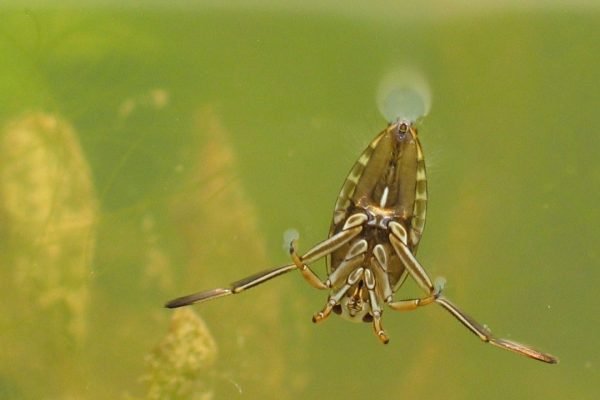
Most of the time smoothies spend on their backs, rowing legs spread out to the sides
For humans, there is also a peculiar benefit of the water bug as a food product. In Asian cuisine, it is considered a delicacy, and in Mexico, smooth eggs are eaten.
Description of smoothies
Smoothies are called large bugs that live in fresh water. They are distinguished into a separate genus belonging to the family of Gladyshevs: in total, it includes more than three hundred species, and seven live on the territory of Russia. Smoothies resemble other water bugs - belostom, but they are much smaller - 1.5 cm in comparison with 15 cm.In the Eurasian region, these bugs are widespread and live in stagnant reservoirs, they can also live in puddles and even in barrels of water.
Smoothies species differ in habitat, color and size (7–18 mm)
The body of a smooth man is divided into head, chest and abdomen. In general, it resembles a boat: this shape allows the insect to move easily in the water. The name of the bug speaks of its appearance - the body of the smoothie is smooth, which gives it additional streamlining and contributes to better swimming. There is also a device for swimming: the hind pair of the insect's limbs (there are three such pairs in the bug) resembles the structure of an oar, thanks to which the bug cuts the water. The smoothie swims on the back; from a great height it can be mistaken for a leaf of a plant. These bugs breathe air, and the respiratory organ is at the rear end of the abdomen, so they spend most of their time putting this part of the body out of the water. Depending on the reservoir in which the bug lives, the color can change: smoothies, like many animals, can adapt their appearance to their habitat. The abdomen of the bug is darker than the back (elytra), on which there are various geometric patterns that give the glabella an attractive appearance. Reddish eyes are visible on the insect's head.
Growing at home and in the country
Smoothies are quite suitable for growing a house in a garden area.Mycelium can be found in specialized stores, and the planting and care technology is similar to milk mushrooms. First of all, you should take care of the tree, which will create the necessary tandem (mycorrhiza) with the mycorrhiza. Pine or birch are suitable for this, the age of the tree should not be more than 4 years.
It will require the preparation of a nutrient substrate, preferably with a high content of peat. You will need sawdust, fallen leaves and moss, which is best harvested in those places where smoothies grow. To create an enabling environment, you will need:
- Mix garden soil with sawdust, which must first be steamed in a water bath or spilled with boiling water.
- Around the selected tree, as close to the trunk as possible, dig a trench 1 m wide and up to 15 cm deep. This should be done carefully so as not to damage the roots of the plant.
- Put the mixture from the ground with sawdust (1: 1) on the bottom of the dug hole, scatter the mycelium of the mushroom over its surface.
- Sprinkle on top with the rest of the soil, lay the moss and cover everything with fallen leaves.
The first time, immediately after planting, it should be watered with a solution of lime, this will help to disinfect the soil. To create it, you need to dilute 50 g of dry lime in 10 liters of water. The best time for planting is summer, but if the mycelium is purchased at another time of the year, then it can be grown in a greenhouse. Watering is carried out often and abundantly - once a week, at least 30 liters of water should be poured under each tree. The smoothie does not like direct sunlight, but the creation of a strong shadow will have a bad effect on the result. There should be a lot of light (diffused).
How to cook
In the north of the country, Gladysh is considered a rather tasty mushroom. There it is known as an ingredient in many dishes. Salted smoothies are especially famous for their original taste. Fans of all kinds of snacks will appreciate the sour taste of crispy mushrooms, which are not inferior to, for example, volushki.
Gladysh belongs to the second category of edible mushrooms. It is used for salting after prolonged soaking and blanching. It is boiled for about 10 minutes, then poured over with cool water to remove the milky juice. After salting, the mushroom takes on a bright yellow color.
Recipe for salty smoothies and other mushrooms
There is a proven recipe for pickling mushrooms that can be used not only for smoothies. Before salting the milkmen, it is necessary to clear them of debris and earth, and then fill them with water for 24 hours. The fluid must be changed periodically. After that, the mushrooms are blanched in salted water for ten minutes and the broth is drained. For a marinade for two kilograms of mushrooms, you will need:
- 500 ml of water;
- pepper and salt to taste;
- laurel leaves;
- head of garlic;
- dill umbrellas;
- black currant sheets;
- five large spoons of salt;
- sunflower oil.
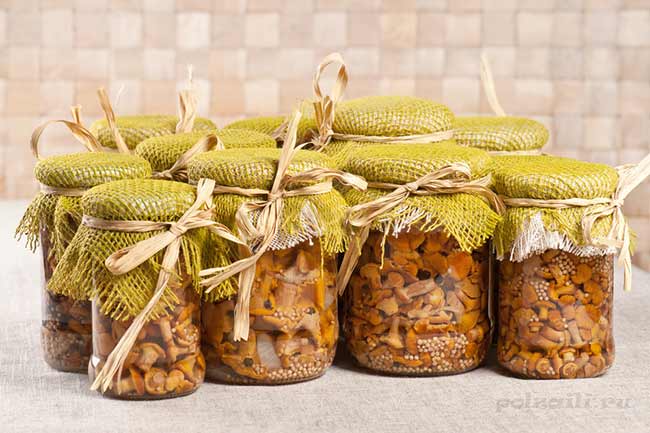
Step-by-step salting:
- Prepared mushrooms are placed in a large saucepan and covered with water.
- Pour salt there and mix.
- Cook on the stove for 45 minutes.
- When the composition boils, they throw bay leaf and pepper into the pan.
- After the time has elapsed, the marinade is poured into a separate bowl and set aside.
- Jars are sterilized and mushrooms are placed in them along with garlic cloves and dill.
- Sheets of black currant are placed in each container.
- A pinch of salt is poured into the set aside brine and mushrooms are poured into it. Put a clove of garlic on top and pour two tablespoons of sunflower oil each.
- Banks are being rolled up.
To prevent mushrooms from spoiling, you should boil thoroughly and roll up the jars well. In order not to earn an eating disorder and spoil the taste of the dish, you cannot ignore the procedure for preparing smoothies. Both hot and cold cooking methods are suitable for salting. In any case, the common lactarius is pickled faster than other mushrooms. You can serve a snack on the table after a week.
Description of the gray-pink milky
The hat of the gray-pink lactarius is large - its diameter is 8-15 centimeters. The shape of the cap is more or less rounded. In the central part there may be a tubercle or, on the contrary, a depression. With age, both signs can appear at the same time.In young mushrooms, the edges are neatly tucked up, and gradually open with age. The color of the cap is difficult to describe, there are dull grayish, brown, pinkish tones. The surface is velvety and dry. The hat is not prone to hygrophilousness.
The pulp is brittle, thick, whitish in color, with a strong pleasant odor and a burning taste. Milky juice is watery, it stands out poorly. Adult mushrooms may not have milky juice at all. The plates are of medium frequency, slightly descending on the stem, of the same color with the cap or slightly lighter. Yellowish spore powder.
The leg is rather short and thick, its height is 5-8 centimeters, with a width of 1-2 centimeters. But when gray-pink milky grows in mosses, their legs can be much longer. The surface of the leg is smooth, gray-pink in color. The leg is strong in structure.

The spread of inedible milk mushrooms
These mushrooms grow in swamps. They can be found in mosses, birches and pines. Inedible milk mushrooms bear fruit from August to September. Under favorable conditions, they can grow in great numbers.
Edible gray-pink lactarius
The gray-pink miller is a conditionally edible mushroom. And in foreign literature they are referred to as weakly poisonous mushrooms. In our country, these mushrooms are sometimes considered inedible. These are low-value mushrooms, they are harvested when there are no commercial types of mushrooms. They have a strong specific smell, which is why they make an unpleasant impression on mushroom pickers.
Related species of inedible weight
The zoneless milky is widespread in Eurasia. These mushrooms are found in deciduous forests. Form mycorrhiza with oak trees. They live singly or in small groups. Fruiting from July to September. In lean years, they may not bear fruit at all.

The cap of the zoneless milk-keeper is flat, with a tubercle in the middle, its edges are even. The diameter of the cap is 9-11 centimeters. Its surface is velvety, sandy, brown, pale brown or dark brown. The leg is hollow, in shape it resembles a cylinder. The leg and the cap are monochromatic. The leg height is 7-9 centimeters. In young specimens, the legs are dense, and with age they become hollow.
The zoneless milky is an edible species. Suitable for pickling and salting. It is recommended to collect only young milkmen.
The zonal milky or oak mushroom is widespread almost everywhere, giving preference to broad-leaved forests with beech, oak and birch. Fruiting singly or in small groups. They are found from July to September. These mushrooms are conditionally edible and must be soaked before cooking to remove the bitterness.
The diameter of the zonal lactarius cap reaches 10 centimeters. The cap is very fleshy, at first funnel-shaped, then it becomes flat with raised edges. The surface of the cap is dry and becomes sticky in the rain.

The color of the cap is cream or ocher. The stem is central, very dense, cylindrical, hollow inside. Its color ranges from white to buffy. There may be a red patina on the stem.
Cooking Recipes
The common miller belongs to the conditionally edible mushrooms of the second category. When salted, it acquires a pleasant sour taste that distinguishes it from many other mushrooms. After salting, it becomes a bright yellow color.
Primary processing
First, you should clean the fruits of forest debris, inspect for rot and, if found, remove. The miller is not affected by worms, and therefore you should not worry about them.
An important part of pre-cooking the iron is soaking. The procedure lasts a day, and the water changes during this period at least 5 times
After that, the milkmen are ready for further processing.
 Pickling
Pickling
In order to marinate 2 kg of smoothies, you will need:
- water - 1 l;
- salt - 20 g.
For the marinade:
- vinegar - 120 ml;
- salt - 2 tsp;
- sugar - 1 tsp;
- allspice peas - 3 pcs.;
- laurel - 2 leaves;
- cloves - 2 pcs.
After pre-soaking, the mushrooms can be used for pickling. Would need:
- Boil water with 20 g of salt, then add smoothies there and cook for 40 minutes.
- Remove fruits and rinse with cold water.
- Add all the other ingredients to the new water and boil, put the milkers, cook for 15 minutes.
- Then put the mushrooms in prepared jars, pour the marinade to the top and refrigerate on the lower shelf.
For longer storage, sterilization is used.
Hot salting for the winter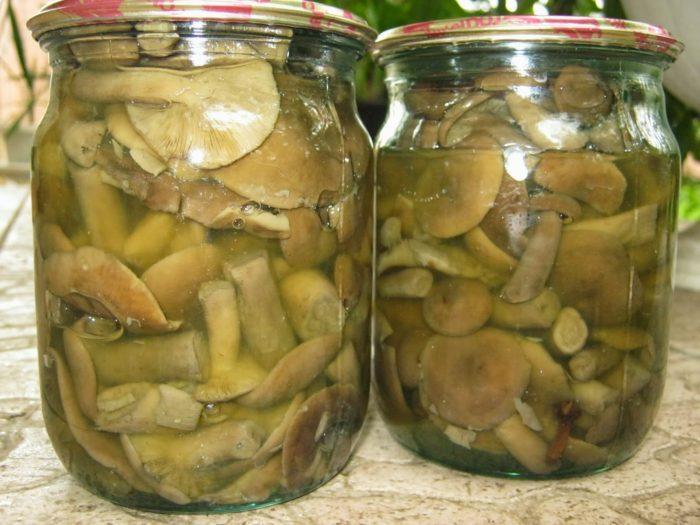
To salt 1 kg of smoothies, you will need:
- water - 0.5 l;
- salt - 2 tbsp. l .;
- garlic - 6 cloves;
- bay leaf - 2 pcs.;
- dill - 3 umbrellas;
- currant leaves - 3 pcs.;
- allspice - 5 peas;
- vegetable oil - 6 tbsp. l .;
- salt to taste.
How to salt:
- Add salt to the water, bring to a boil and add mushrooms there.
- After boiling, put laurel leaves and peppercorns, after 50 minutes, drain the marinade into a separate container.
- Put mushrooms in sterilized half-liter jars, add garlic, dill, currant leaves to each.
- Pour a pinch of salt into the drained brine, mix and pour the mushrooms with the composition so that the liquid completely covers them.
- Put another clove of garlic in each jar and add 2 tbsp. l. vegetable oil. Roll up the lids.
Store the workpieces in a cool, dark place.
Cold salting
Millers are soaked, now they can be salted in the easiest way. To do this, for 1 kg of mushrooms you will need:
- salt - 3 tbsp. l .;
- laurel - 3 pcs.;
- horseradish - 3 pcs.;
- garlic - 3 cloves;
- carnation - 3 buds;
- allspice peas - 6 pcs.
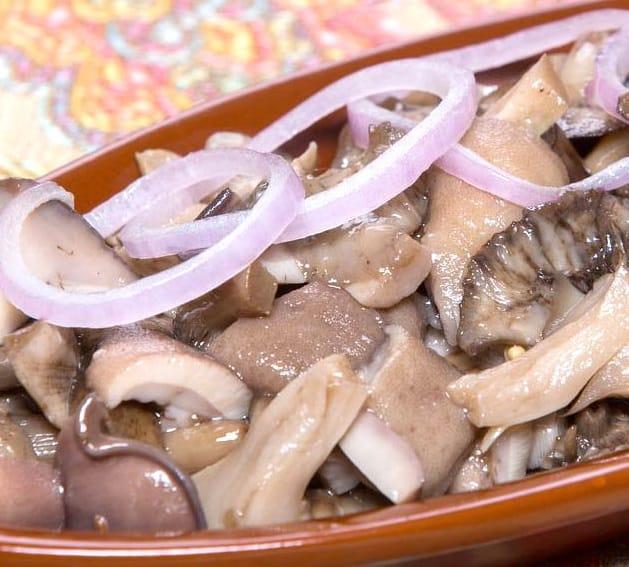 How to prepare:
How to prepare:
- Put some salt in a prepared saucepan on the bottom with a thin layer.
- This is followed by a row of mushrooms, they fit tightly, with their caps down.
- On top of the milkmen, put 1 piece of laurel, horseradish, cloves, chopped garlic clove, 2 peppercorns.
- Further, salt again. Alternate until the mushrooms run out.
- Sprinkle the smooth surfaces with salt on top, cover with gauze folded in several layers and press down with a load.
- You can try mushrooms after a month.
Milkmen are salted in a cool place, it is necessary to rinse the gauze regularly so that mold does not appear. A few days after salting, the mushrooms should be completely covered with their own juice, otherwise the weight of the load should be increased.
Adaptation to the habitat of the common smoothhead
An ordinary smoothfish swims on its back on the surface of the water and resembles a boat: a convex back is the "bottom" of a boat, and a flat abdomen is lifted upward. The dorsal side of smoothies is painted in a whitish, streaked color: this is a disguise for the light surface of the water. The lower part of the body at the smoothie is dark brown, matching the color of the muddy bottom of the reservoir.
The common water bug flies well - like many other water bugs, by the way. The water bug is capable of long-distance flights.
The smoothie rises into the air at night, as a rule, with one goal: to find a body of water rich in food. So these insects fly from reservoir to reservoir, while settling in new places. Sometimes they can even be found in puddles of rain and open containers of water prepared for irrigation. These insects often fly at night and in the light of the lamp.
We offer you to familiarize yourself with Pruning Potentilla shrub in spring
The common smoothie is a predatory insect; it usually "hangs in ambush", lurking at the surface of the water and spreading its legs. Having outlined the victim, he dives deep and then, without making the slightest movement, like a cork pushed out by water, rises in a straight line to the victim and grabs her with his tenacious front limbs.
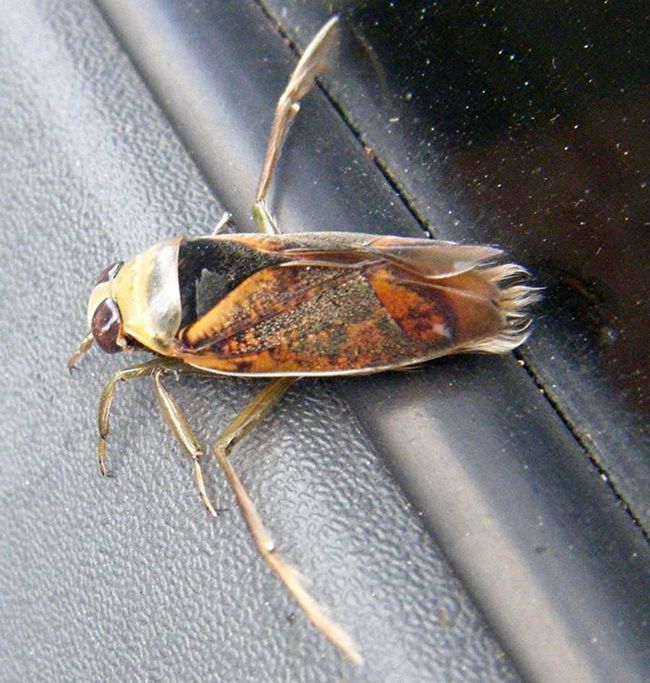
The common smoothie feeds on small aquatic invertebrates, but it can attack even small fish. The prey is struck with a short, hard and very sharp proboscis. Through this proboscis, he injects a poisonous substance into the victim.
Notes [| ]
- Definition of the term "lactarius" in Wiktionary
- Etymological Dictionary of Slavic Languages, Volume 7. - M .: "Science", 1980. - P. 158.
- Fasmer M. Etymological Dictionary of the Russian Language, Volume 1. - M .: "Progress", 1964-1973. - S. 463-464.
- Shansky N.M. School etymological dictionary of the Russian language (inaccessible link) (inaccessible link from 14-06-2016)
- Lyakhov P.R. Encyclopedia of mushrooms.- M .: "EKSMO-Press", 2001. - P. 210. - ISBN 5-04-003208-0.
- Heilmann-Clausen, 1998.
- Basso, 1999.
- Rayner, 2005.
- Bessette, 2009.
- Gorovoy, 1990, p. 140.
- ↑ 12 Kränzlin, 2005, p. 42.
- Kränzlin, 2005, p. 15.
- Heilmann-Clausen, 1998, pp. 19-21.
- Heilmann-Clausen, 1998, p. fourteen.
- Handbook of a novice mushroom picker. Vishnevsky M.V. ISBN 978-5-17-052809-7
- David Moore. A Guide to the World of Fungi on Stamps and other Postal Ephemera. Date of treatment July 2, 2020.
Ecology
All members of the genus are obligate ectomycorrhizal fungi and are found in various types of forests around the world. There are both nonspecific in relation to plant symbionts species, and genus-specific - forming mycorrhiza with several closely related plant species. So, L. quietus
enters into symbiosis only with plants of the genus oak,L. glyciosmus - with birches, andL. deterrimus - with fir trees. Nonspecific mycorrhiza formers in different natural zones also exhibit a certain genus-specificity. Thus, the widespread Holarctic speciesL. rufus in southern Karelia it occurs mainly in pine forests on dry sandy soils, and on the Kola Peninsula - in green moss spruce forests. In the south of Western Siberia, the same species does not show any particular genus-specificity and is found with approximately the same frequency in different types of forests.
Description of the common milkman
The diameter of the flat hat is 7-15 centimeters. The shape of young specimens is wheel-like, while the edges are strongly tucked up, not pubescent. The center of the cap is depressed. Gradually, the cap opens and reaches the funnel-shaped.

The color of the cap is variable - at a young age, the color is brown, lead gray, lilac, light gray and lilac. There are weak concentric circles on the cap, mostly visible at an early stage of development. The surface of the cap is smooth, mucous in rainy weather.
The flesh of the cap is thick, brittle, its color is yellowish. Milky sap is acrid, not too abundant, white, in the air it turns a little green. The pulp has practically no smell. The plates are pale cream in color, quite often located, slightly descending. With age, yellowish spots may appear on the plates, which are formed from leaked milky juice. The color of the spore powder is light yellow.
The leg is cylindrical. Its height is very different - from 5 to 15 centimeters, depending on the place of growth, and the thickness is 1-3 centimeters. The color of the leg is the same as the hat, but slightly lighter. Already in young specimens, the legs become hollow, as they grow, they expand, and at first they are rather neat.

Distribution of smoothies
Ordinary milkmen bear fruit from July to September. They grow in different types of forests and form mycorrhiza with birches and pines. They prefer mossy wet places. Smoothies can appear in significant numbers.
Edible smoothies
Among the northern peoples, smoothies are considered edible mushrooms with decent taste. In our latitudes, ordinary milkmen are less known, they are undeservedly bypassed. When salted, smoothies are fermented faster in comparison with "hard meat" congeners. Soon they have an indescribable sour taste, which is so popular with connoisseurs of salting.
Similar species
Although smoothies have a rich color range, this mushroom is quite recognizable. Due to the different growing conditions, smoothies can be distinguished from externally similar graylings. Common millers have similarities to other types of lactarius, but they can be recognized due to their larger size and lack of a strong odor.

Other mushrooms of this genus
Wet or lilac milky is a conditionally edible mushroom. The height of its legs is 4-7 centimeters, with a thickness of 1-2 centimeters. The leg is cylindrical in shape, slightly widened at the bottom. In structure, it is very strong and strong, and its surface is sticky. The diameter of the cap is 4-8 centimeters, and the shape is initially convex, and then outstretched. The color of the cap ranges from grayish to gray-violet. The edges of the cap are fleecy and bent.
Wet milkmen are rare, they grow in small groups or singly. Distributed in mixed and deciduous forests next to willows and birches. Wet milkers bear fruit from August to September. Some sources claim that these are conditionally poisonous mushrooms, while others claim that they are weakly poisonous.
The brown-yellow milky is an inedible member of the family. The diameter of its cap ranges from 4 to 8.5 centimeters, initially the shape is convex, but over time it becomes concave. The color of the cap varies from reddish brown to dark brown. The leg length is 3-7.5 centimeters, and its thickness is 0.5-2 centimeters. The color of the leg is orange-ocher or orange-brown.

Brown-yellow lactarias grow in mixed and deciduous forests. They grow under deciduous trees, and practically never occur under conifers. They bear fruit actively from July to October. These mushrooms are not suitable for human consumption.
Reproduction and development
The smooth bug is an insect with incomplete transformation. Its development includes three stages
- Egg. In early spring, the female mates with the male, after which she lays up to 200 pieces of yellow eggs on the lower part of aquatic plants.
- Larva. After about two weeks, the eggs hatch into larvae. They are similar to adult insects, but wingless and light green in color. During the summer, there are three molts, with each young bug the structure changes slightly - in the last molt, the rudiments of wings already appear.
- Imago. By August, the bug molts for the fourth time and becomes an adult insect. Its development ends there, however, the chitinous cover hardens and acquires its final color only after some time.
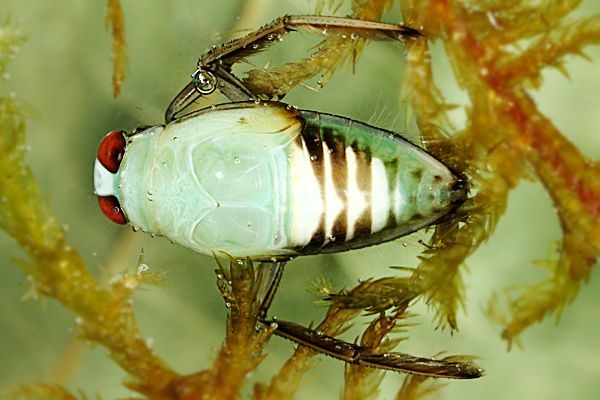
The larvae of smoothies resemble adult bugs in structure, but are much lighter in color and do not have wings.

